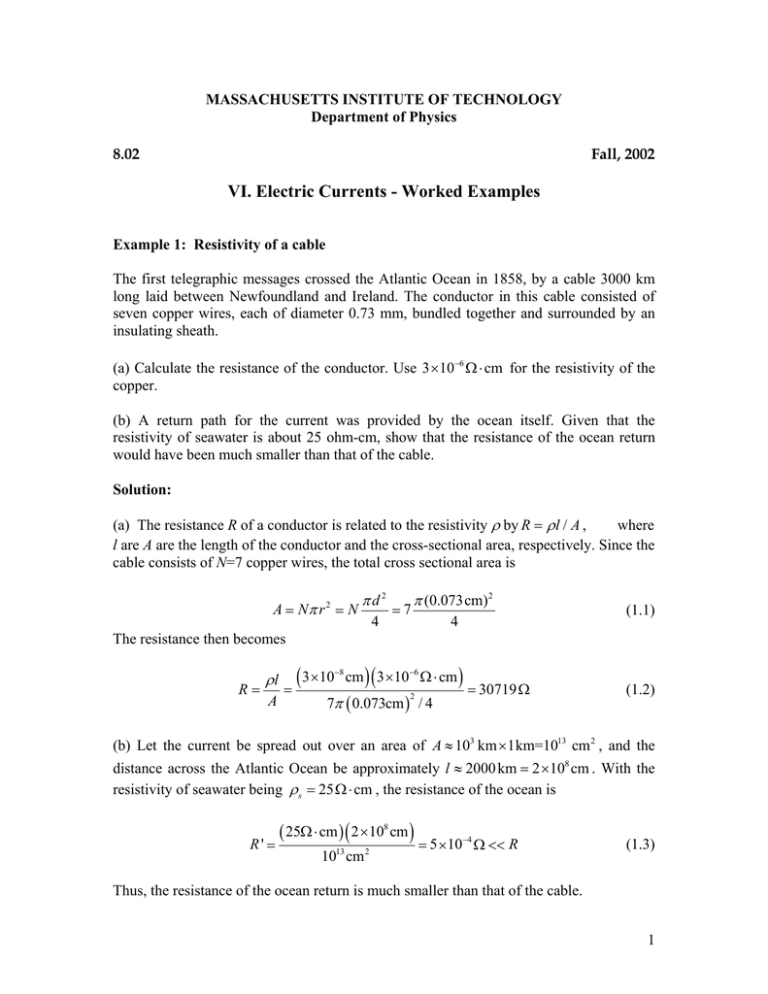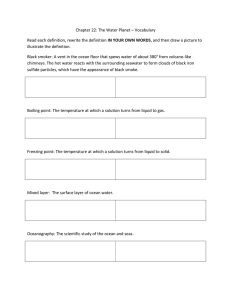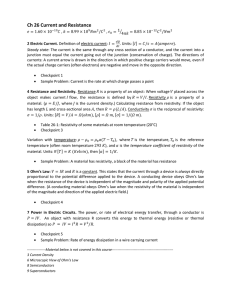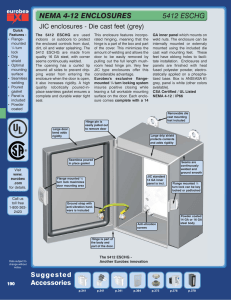VI. Electric Currents - Worked Examples
advertisement

MASSACHUSETTS INSTITUTE OF TECHNOLOGY Department of Physics 8.02 Fall, 2002 VI. Electric Currents - Worked Examples Example 1: Resistivity of a cable The first telegraphic messages crossed the Atlantic Ocean in 1858, by a cable 3000 km long laid between Newfoundland and Ireland. The conductor in this cable consisted of seven copper wires, each of diameter 0.73 mm, bundled together and surrounded by an insulating sheath. (a) Calculate the resistance of the conductor. Use 3 × 10−6 Ω ⋅ cm for the resistivity of the copper. (b) A return path for the current was provided by the ocean itself. Given that the resistivity of seawater is about 25 ohm-cm, show that the resistance of the ocean return would have been much smaller than that of the cable. Solution: where (a) The resistance R of a conductor is related to the resistivity ρ by R = ρ l / A , l are A are the length of the conductor and the cross-sectional area, respectively. Since the cable consists of N=7 copper wires, the total cross sectional area is A = Nπ r 2 = N πd2 4 =7 π (0.073cm)2 4 (1.1) The resistance then becomes R= ρl A ( 3 ×10 = −8 cm )( 3 ×10−6 Ω ⋅ cm ) 7π ( 0.073cm ) / 4 2 = 30719 Ω (1.2) (b) Let the current be spread out over an area of A ≈ 103 km × 1km=1013 cm 2 , and the distance across the Atlantic Ocean be approximately l ≈ 2000 km = 2 × 108 cm . With the resistivity of seawater being ρ s = 25 Ω ⋅ cm , the resistance of the ocean is R' = ( 25Ω ⋅ cm ) ( 2 ×108 cm ) 13 10 cm 2 = 5 × 10−4 Ω << R (1.3) Thus, the resistance of the ocean return is much smaller than that of the cable. 1 Example 2: Charge at junction Show that the total amount of charge at the junction of the two materials in the figure 1 1 below is ε 0 I ( − ) , where I is the current flowing through the junction, and σ 1 and σ2 σ1 σ 2 are the conductivities for the two materials. Solution: G In a steady state of current flow, the normal component of the current density J must be the same on both sides of the junction. Since J = σ E , we have σ 1 E1 = σ 2 E2 (2.1) σ E2 = 1 E1 σ 2 (2.2) or Let the charge on the interface be Qin, we have, from the Gauss’s law: G G v∫ E ⋅ dA = ( E 2 − E1 ) A = S Qin ε0 or E2 − E1 = Qin Aε 0 (2.3) Substituting E2 using Equation (2.2) then yields σ 1 1 Qin = ε 0 AE1 1 − 1 = ε 0 Aσ 1 E1 − σ2 σ 2 σ1 (2.4) Since the current is I = JA = (σ 1 E1 ) A , the above expression becomes 1 1 − Qin = ε 0 I σ 2 σ1 (2.5) 2 Example 3: Drift velocity The resistivity of seawater is about 25 ohm-cm. The charge carries are chiefly Na + and Cl- ions, and of each there are about 3 × 1020 per cm3 . If we fill a plastic tube 2 meters long with seawater and connect a 12-volt battery to the electrodes at each end, what is the resulting average drift velocity of the ions, in cm/sec? Solution: The current in a conductor of cross sectional area A is related to the drift speed vd of the charge carriers by I = enAvd (3.1) where n is the number of charges per unit volume. We can then rewrite the Ohm’s law as ρl V = IR = ( neAvd ) = nevd ρ l A (3.2) which yields vd = V ne ρ l (3.3) Substituting the values, we have vd = 12V ( 6 ×10 cm )(1.6 ×10−19 C ) ( 25Ω ⋅ cm )( 200cm ) 20 -3 V ⋅ cm cm = 2.5 ×10 = 2.5 × 10−5 C⋅Ω s (3.4) −5 In converting the dimensions we have used V V 1 ampere −1 = = =s C Ω⋅C Ω C 3 Example 4: Circuit Consider the circuit shown below, for a given resistance R0 , what must be the value of R1 so that the input resistance between the terminals is equal to R0 ? Solution: The equivalent resistance, R’, due to the three resistors on the right is R0 + 2 R1 1 1 1 = + = R ' R1 R0 + R1 R1 ( R0 + R1 ) or R' = R1 ( R0 + R1 ) R0 + 2 R (4.1) (4.2) Thus, the equivalent resistance due to the four resistors becomes Req = R1 + R1 ( R0 + R1 ) 3R12 + 2 R1 R0 = R0 + 2 R1 R0 + 2 R1 (4.3) If Req = R0 , then R0 ( R0 + 2 R1 ) = 3R12 + 2 R1 R0 ⇒ R0 2 = 3R12 (4.4) or R1 = R0 3 (4.5) 4 Example 5: Show that, if a battery of fixed emf ε and internal resistance Ri is connected to a variable external resistance R , the maximum power is delivered to the external resistor when R = Ri Solution: Using Kirchhoff’s rule, ε = I ( R + Ri ) which implies I= (5.1) ε (5.2) R + Ri The power dissipated is equal to P=I R= 2 ε2 ( R + Ri ) 2 R (5.3) To find the value of R which gives out the maximum power, we differentiate P with respect to R and set it to be 0: R −R 1 2R dP =ε2 − =ε2 i =0 2 2 3 dR ( R + Ri ) ( R + Ri ) ( R + Ri ) (5.4) R = Ri (5.5) which implies 5






